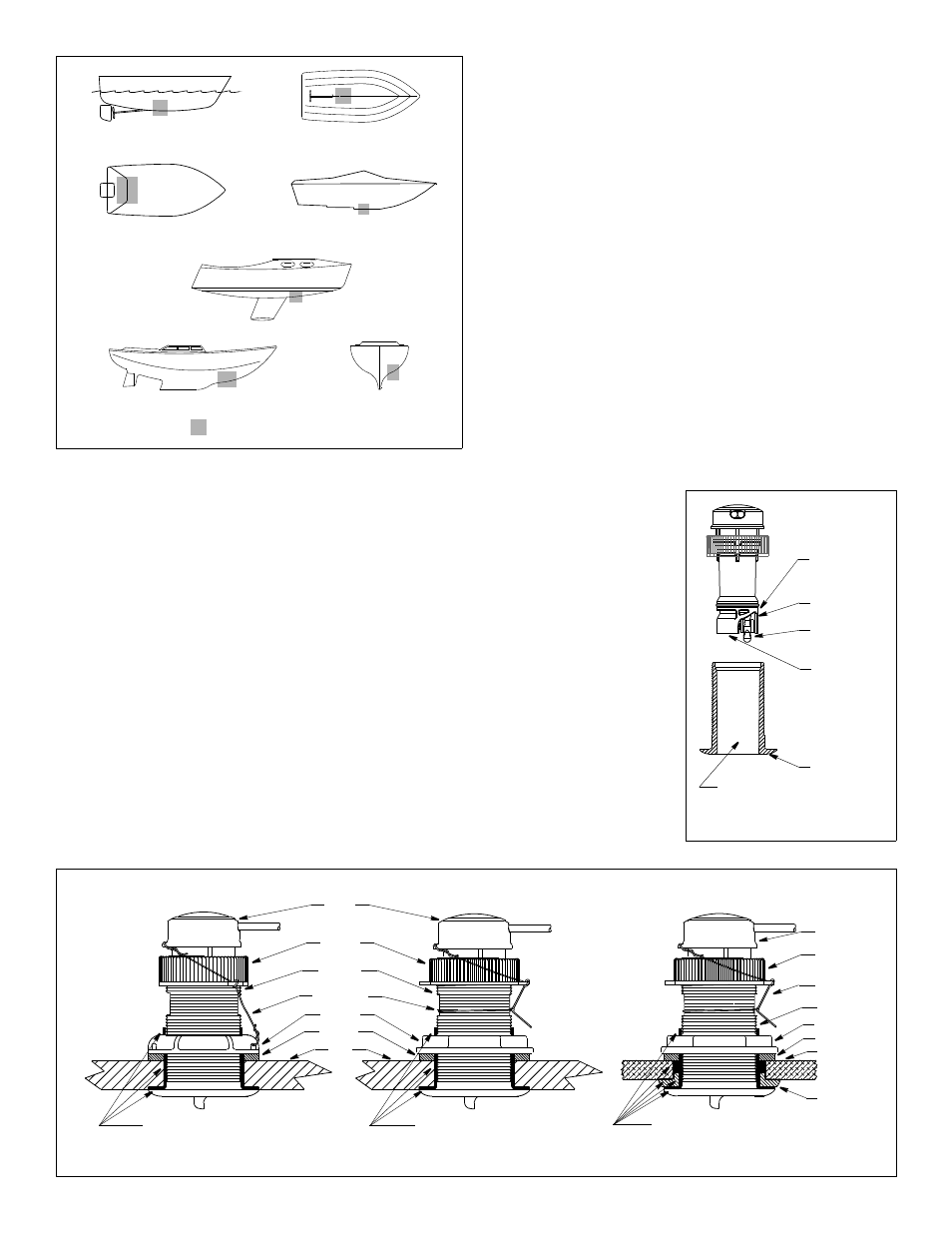Mounting location, Anti-fouling paint, Hull types – Airmar DST800 Retractable without Valve—TRIDUCER® Multisensor User Manual
Page 2

Mounting Location
CAUTION: Do not mount near water intake or discharge
openings, or behind strakes, fittings, or hull irregularities.
• The water flowing under the hull must be smooth with a
minimum of bubbles and turbulence (especially at high speeds).
• The multisensor must be continuously immersed in water.
• The transducer beam must be unobstructed by the keel or
propeller shaft(s).
• Choose a location away from interference caused by power and
radiation sources such as: the propeller(s) and shaft(s), other
machinery, other echosounders, and other cables. The lower
the noise level, the higher the echosounder gain setting that
can be used.
• Choose a location with a minimal deadrise angle, so the
transducer beam will be aimed at the bottom.
• Choose an accessible spot inside the vessel with adequate
headroom for the height of the housing, tightening the nuts, and
removing the insert. Allow a minimum of 280mm (11").
Hull Types
(see Figure 1)
• Displacement hull powerboats—Locate amidships near the
centerline. The starboard side of the hull where the propeller blades
are moving downward is preferred.
• Planing hull powerboats—Mount well aft, on or near the centerline,
and well inboard of the first set of lifting strakes to insure that the
multisensor will be in contact with the water at high speeds. The
starboard side of the hull where the propeller blades are moving
downward is preferred.
Outboard and I/O—Mount just forward of the engine(s).
Inboard—Mount well ahead of the propeller(s) and shaft(s).
Stepped hull—Mount just ahead of the first step.
Boat capable of speeds above 25kn (29MPH)—Review the
installation location and operating results of similar boats before
proceeding.
• Fin keel sailboats—Mount on or near the centerline and forward of
the fin keel 300–600mm (1–2').
• Full keel sailboats—Locate amidships and away from the keel at
the point of minimum deadrise.
Anti-fouling Paint
Aquatic growth can accumulate rapidly on the multisensor’s surface
reducing performance within weeks. Surfaces exposed to salt water
must be coated with anti-fouling paint. Use water-based anti-fouling
paint only. Never use ketone-based paint, since ketones can attack
many plastics possibly
damaging the sensor.
It is easier to apply anti-fouling
paint before installation, but
allow sufficient drying time.
Reapply paint every 6 months
or at the beginning of each
boating season. Paint the
following surfaces ( Figure 2):
• Outside wall of the insert
below the lower O-ring
• Paddlewheel cavity
• Paddlewheel
• Exposed end of the insert
• Exterior flange of the
housing
• Bore of the housing up
30mm (1-1/4")
• Blanking plug below the
lower O-ring including the
exposed end
2
planing hulls
Figure 1.
full keel sailboats
large displacement hulls
small displacement hulls
fin keel sailboats
Best location for multisensor
Copyright © 2005 Airmar Technology Corp.
stepped hull
outboard and I/O
marine sealant on flange and
Figure 3. Bedding and installing
cap nut
washer
hull
plastic housing
safety wire
housing
hull nut
insert
marine sealant on flange
stainless steel housing in metal hull
metal housing in non-metal hull
isolation
ring
washer
sidewall of housing
(plastic)
marine sealant on flange
cap nut
hull
safety wire
housing
insert
(plastic)
(metal)
hull nut
Copyright © 2005, 2006 Airmar Technology Corp.
BOW
►
and sidewall of housing
and sidewall of housing
and isolation bushing where it contacts the hull
P17
B17
SS577
Figure 2. Anti-fouling paint
outside wall
paddlewheel
paddlewheel
bore up
exterior flange
O-ring
below lower
cavity
30mm (1-1/4")
of housing
insert
housing
exposed end
Copyright © 2006 Airmar Technology Corp.
